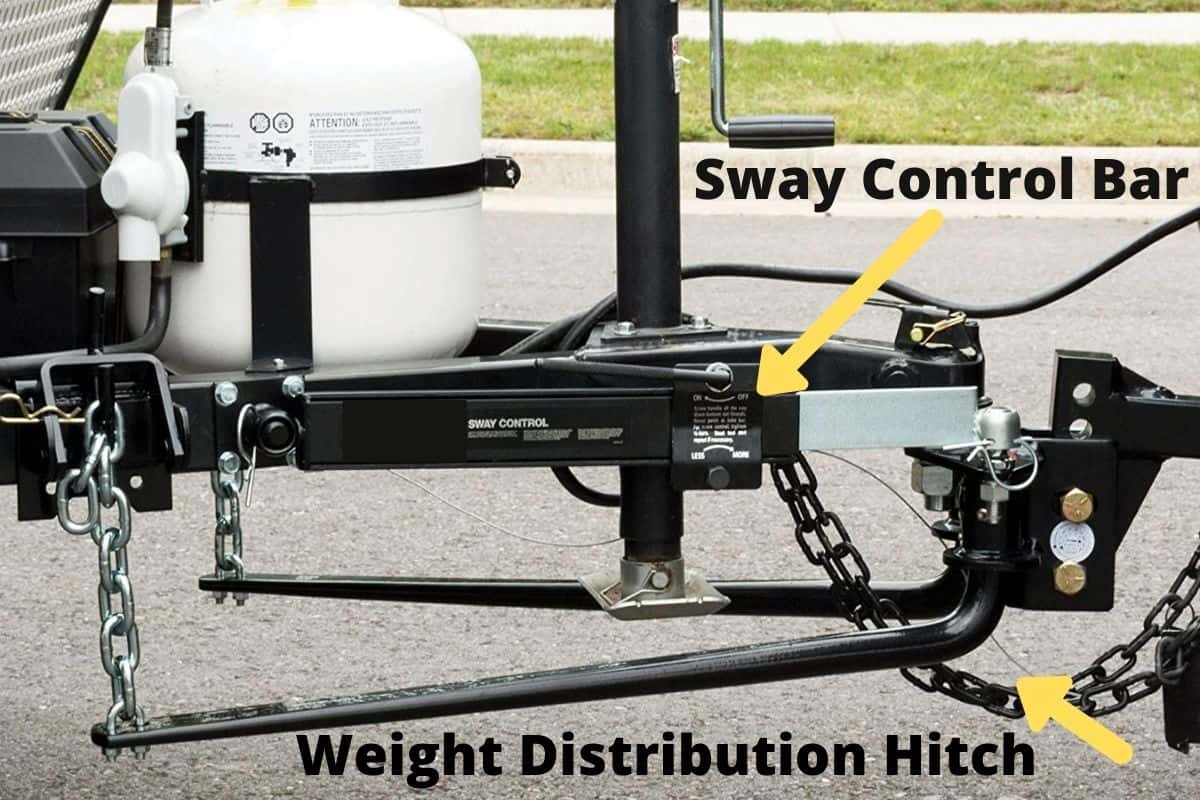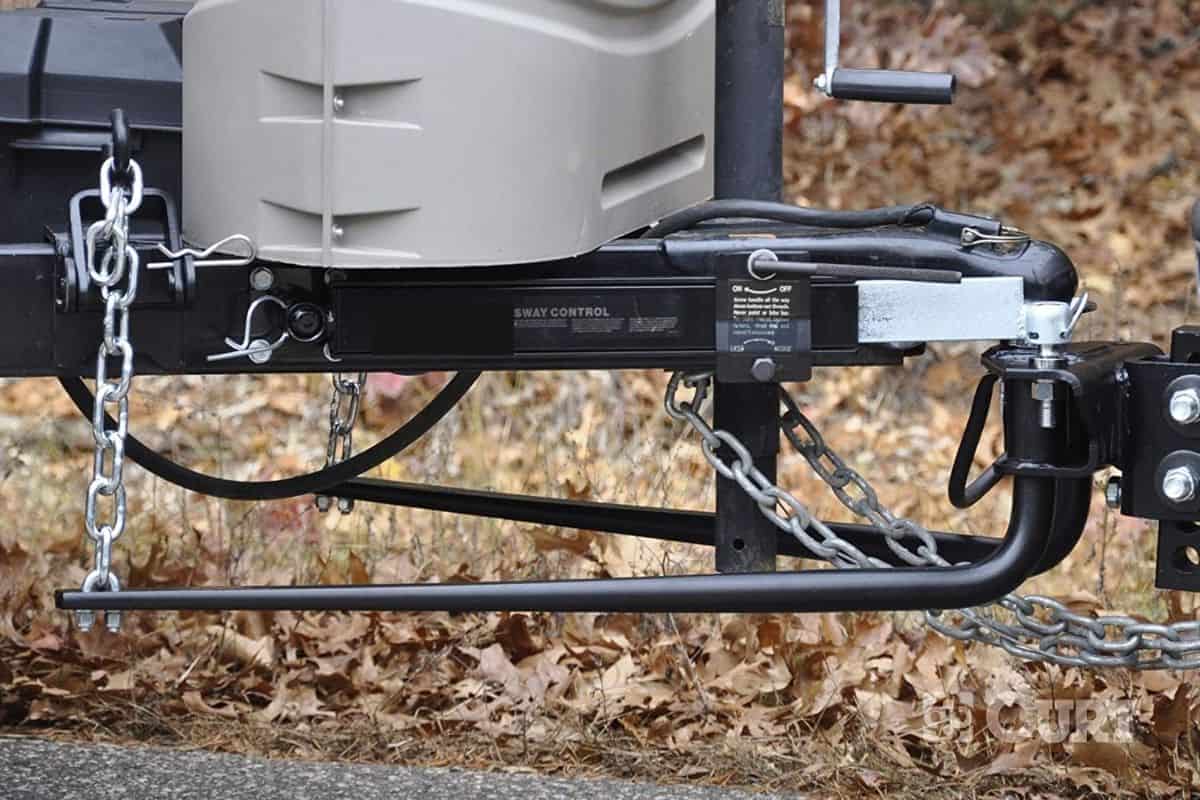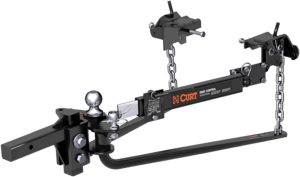If you’ve recently purchased a new travel trailer then you more than likely have heard about trailer sway bars and all the benefits they provide.
But what are trailer sway bars and are they even necessary?
Trailer sway bars are bars that attach to and provide an additional connection point between the tow hitch and the tongue of the trailer that reduces and dampens trailer sway through friction.
There’s a lot more to know about trailer sway bars though than just their basic purpose. So if you’re thinking about purchasing trailer sway bars or want a more in-depth explanation about how they work, keep reading.
In-Depth Explanation on How Trailer Sway Bars Work

Why Does My Travel Trailer Sway?
The hitch point between the tow vehicle and the travel trailer is essentially one big hinge allowing the truck and trailer to move independently from one another.
This hinge point between the tow vehicle and the travel trailer is important because it allows the rig to turn easier and adjust for elevation differences between the tow vehicle and the trailer on uneven terrain.
However, this hinge point can also cause trailer instability and trailer sway.
Trailer sway is caused when untended outside forces act on the hinge point between the tow vehicle and the trailer, causing the trailer to sway back and forth.
Which can lead to a challenging tow or even an accident if the trailer sway becomes out of control.
The four main outside forces that cause a travel trailer to sway include wind, crosswinds from passing vehicles, improperly aligned tires on the travel trailer, and improper weight distribution between the tow vehicle and the travel trailer.
Why Every Travel Trailer Should Be Equipped with Trailer Sway Bars
While you can technically pull a travel trailer without sway bars, in our opinion you should always have trailer sway bars equipped to help provide the easiest and safest tow possible.
This is because sway bars do a great job of dampening and even eliminating unintended sway in the trailer by creating a more rigid hitch point between the tow vehicle and travel trailer.
Creating a much safer and more manageable towing experience no matter the outside forces you might encounter while towing such as high winds or crosswinds from passing vehicles.
Trailer Sway Bar Installation
While there can be differences in the way you install a sway bar to your trailer depending on the type and brand of the sway bar, this video as well as these step-by-step directions should give you a good general idea of how to install a sway bar to your trailer.
- Mount the sway control ball to the hitch.
- Attach the trailer tongue ball plate using the included bolts by drilling and screwing the plate to the trailer tongue. (Before drilling, make sure there are no electrical or gas lines in your way, and if the tongue ball plate requires any welding make sure a qualified welding professional completes the welds.)
- Apply a small amount of grease to both sway control balls.
- Attach and secure the socket of the sway bar over the sway control ball on the hitch.
- Adjust and attach the body of the sway control arm to the sway control ball on the tongue ball plate.
- Tighten the sway bar control as recommended by the manufacturer.
- Once installed, make sure the trailer sway bar has free range of motion and does not make contact with either the bumper or the trailer frame and ensure it does not become fully compressed by slowly backing the trailer into a jackknife position on either side.
Do You Need One or Two Sway Bars on the Trailer?
For most travel trailers, one sway bar is usually enough as one sway bar is intended for travel trailers that are less than 6,000 pounds and less than 26 feet long.
If however, you have a larger travel trailer that is over 6,000 pounds or longer than 26 feet, you should install a trailer sway bar to both sides of your trailer to prevent unwanted sway on your trailer.
What’s the Difference Between Trailer Sway Bars and a Weight Distribution Hitch?
It’s not uncommon for beginning RVers to be confused about the differences between a trailer sway bar and a weight-distribution hitch and sometimes even think they are the same thing.
But while they can be sold together as a set, a trailer sway bar and a weight-distribution hitch are two separate pieces of equipment that are designed to do very different things.
Trailer Sway Bar
A trailer sway bar such as this popular one on Amazon by Reese is a device that helps to prevent the trailer from swaying back and forth while going down the road by adding an additional connection point or arm between the tow hitch and the trailer tongue, by using friction to make the hinge point between the tow vehicle and the travel trailer stiffer.
While a trailer sway bar can be a part of an overall tow system that might include a sway bar as well as weight-distribution hitch they are also sold separately like the one above.
Weight Distribution Hitch
A weight-distribution hitch like this popular one on Amazon by Curt that also has a sway bar built-in, is a device that helps to move some of the tongue weight of the trailer to the front axle of the tow vehicle using downward pressure and leverage.
The reason you would use a weight-distribution hitch to move some of the trailer tongue weight from the hitch point to the tow vehicle’s front axle is to prevent sag at the hitch point between the tow vehicle and the trailer and to help keep the tow vehicle level.
This helps to prevent the front wheels of the tow vehicle from lifting up which can lead to poor steering and stopping power.
Do Fifth Wheels Sway or Need Trailer Sway Bars?
While it’s possible for a fifth to sway during extremely windy conditions, in general, fifth wheels do not sway or need trailer sway bars as other travel trailers do.
This is because the trailer hitch point on a fifth wheel is brought forward over the rear axle of the tow vehicle instead of behind it, allowing the tow vehicle and fifth wheel to act more like a signal vehicle as opposed to separate ones.
Because of this many RVers find fifth wheels more stable and in general easier to tow compared to standard travel trailers once they get used to the fifth wheel’s larger size.
Want to know how the “80 Rule for Towing” influences max towing capacity, if so, check out our article “How the 80 Rule for Towing Affects Max Tow Capacity“.
Recent Posts
When cruising down the highway in your RV, the last thing you want is a tire blowout! Not only is it dangerous, but RV tire replacement isn't cheap, costing $200 to $300 per tire. The good news,...
Nothing ruins an RV adventure faster than a breakdown with no way to fix it. Because of this, every RVer should have a well-stocked RV tool kit for those unexpected roadside emergencies and campsite...



